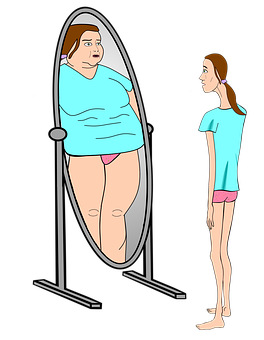A young person with an eating disorder can experience a wide range of physical and psychological health problems. Although rapid weight loss or being very underweight for these to occur. Severe weight loss can cause hair and nails to grow brittle, and skin to dry out, become yellow and develop a covering of soft hair. It can also cause the slowing of growth and delay of puberty. There can be muscle and cartilage deterioration. Loss of bone density that may lead to osteoporosis and fractures, irregular or slow heartbeat, anemia, swollen joints, light-headedness and fainting.

Physical signs and symptoms of repeated vomiting include tooth decay (due to the acid in vomit), chronically inflamed and sore throat, severe dehydration, stomach and intestinal ulcers, and inflammation of the esophagus.
Serious health consequences associated with eating disorders include severe malnutrition, brain dysfunction, and heart or kidney failure. Cardiac arrest is the most common complications that lead to death. Bulimia is less frequently a cause of death than anorexia, however heart failure and death from other causes can occur in either disorder.
Overweight and obesity are associated with illness and premature death. Although these are less likely to affect people while they are still young, childhood and adolescent overweight and obesity can persist into adulthood. In the long term, there is a risk of cardiovascular disease, type II diabetes, arthritis and many other chronic illnesses.
Eating disorders frequently occur together with depression, anxiety disorders and substance use disorders. When adolescents with eating disorders are followed into adulthood, most individuals recover from the eating disorder but continue to have a high level of depression and anxiety.

A range of biological, psychological and social factors may be contributing factors. The following factors increase a person's risk of developing an eating disorders:
▪Pressure to be slim because of occupation
▪ Parental obesity
▪ Family history of dieting
▪ Low self-esteem
▪ Anxiety
▪ Obesity
▪ Early start of periods in girls (<12 years. Increase risk for anorexia and bulimia).
➡ Who can help out of this problem:
▪ Mental health professionals such as psychologist and psychiatrists can offer psychological therapy for eating disorders and co-occurring conditions, and psychiatrists can prescribe any necessary medications.
▪ Dietitian may be helpful to incorporate education about nutritional needs and planning and monitoring eating choices.
Portions of your writing do not appear to be original. Your text appears to originate from the following article that was posted some time ago:
-Eating Disorders - First Aid Guidelines
I have listed an example below. Are you the original author of the referenced articles?
Here are a couple of articles you should follow to make your time in the Hive community more enjoyable and profitable:
It's amazing how you were able to decipher this.
Damn, this is really bad that such a nice and exquisite post is being down voted immensely because of plagiarism.